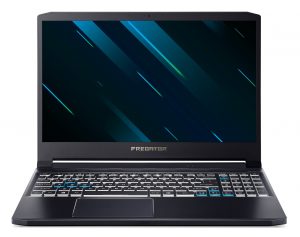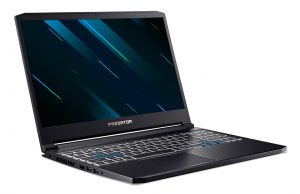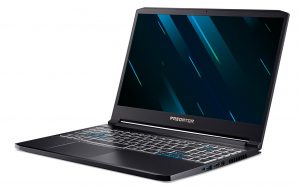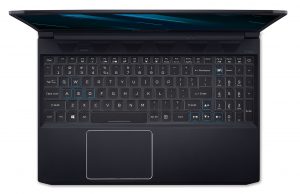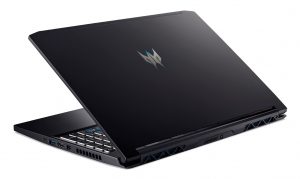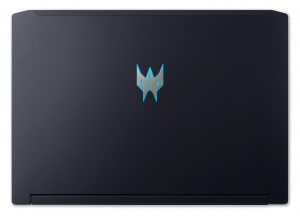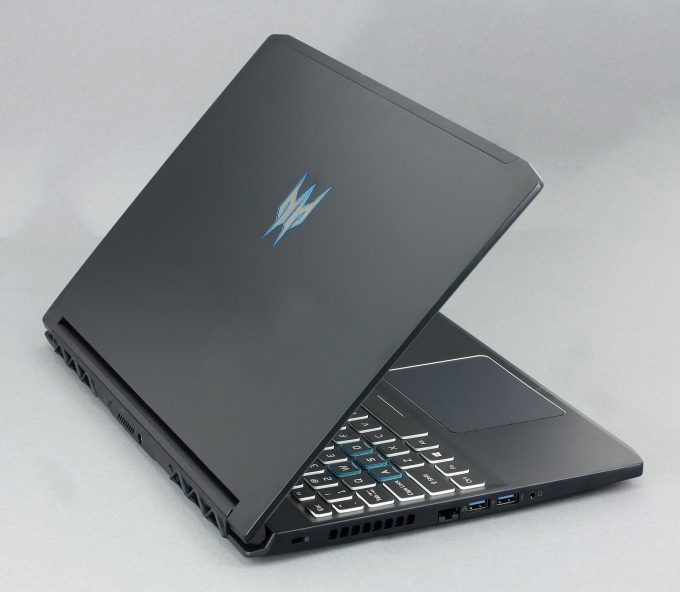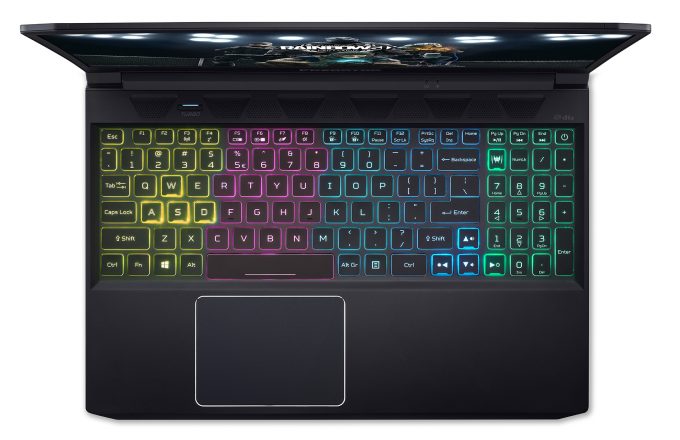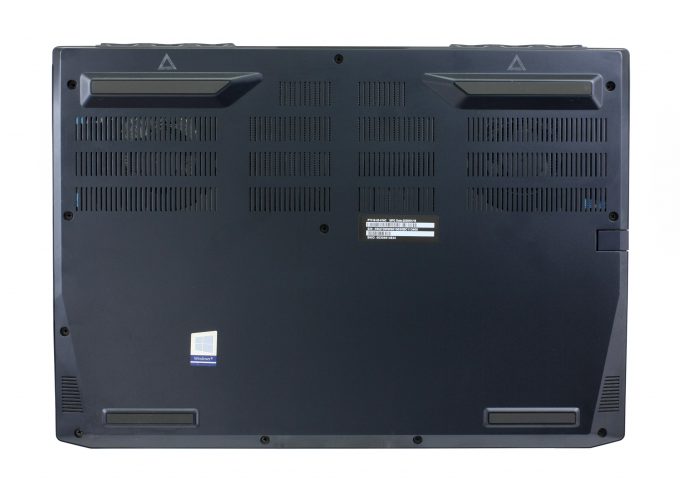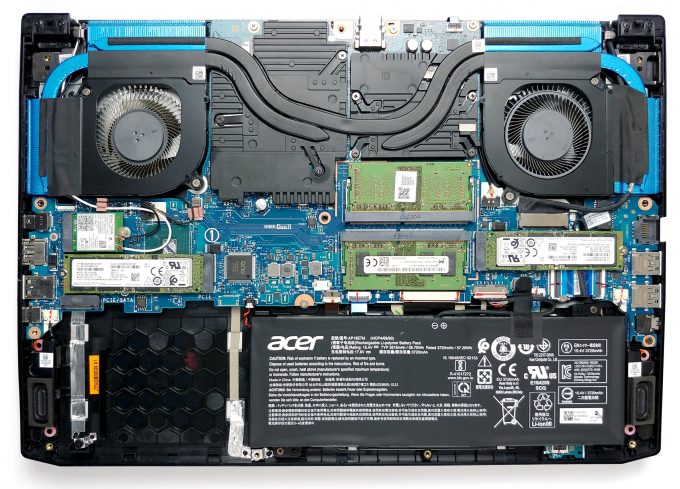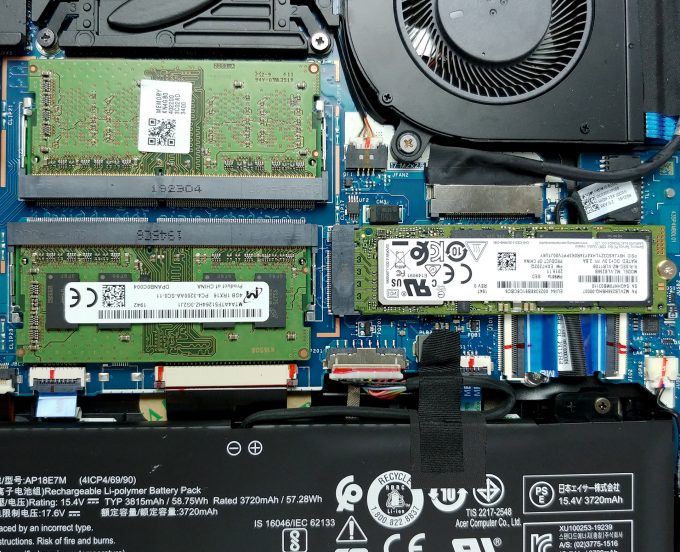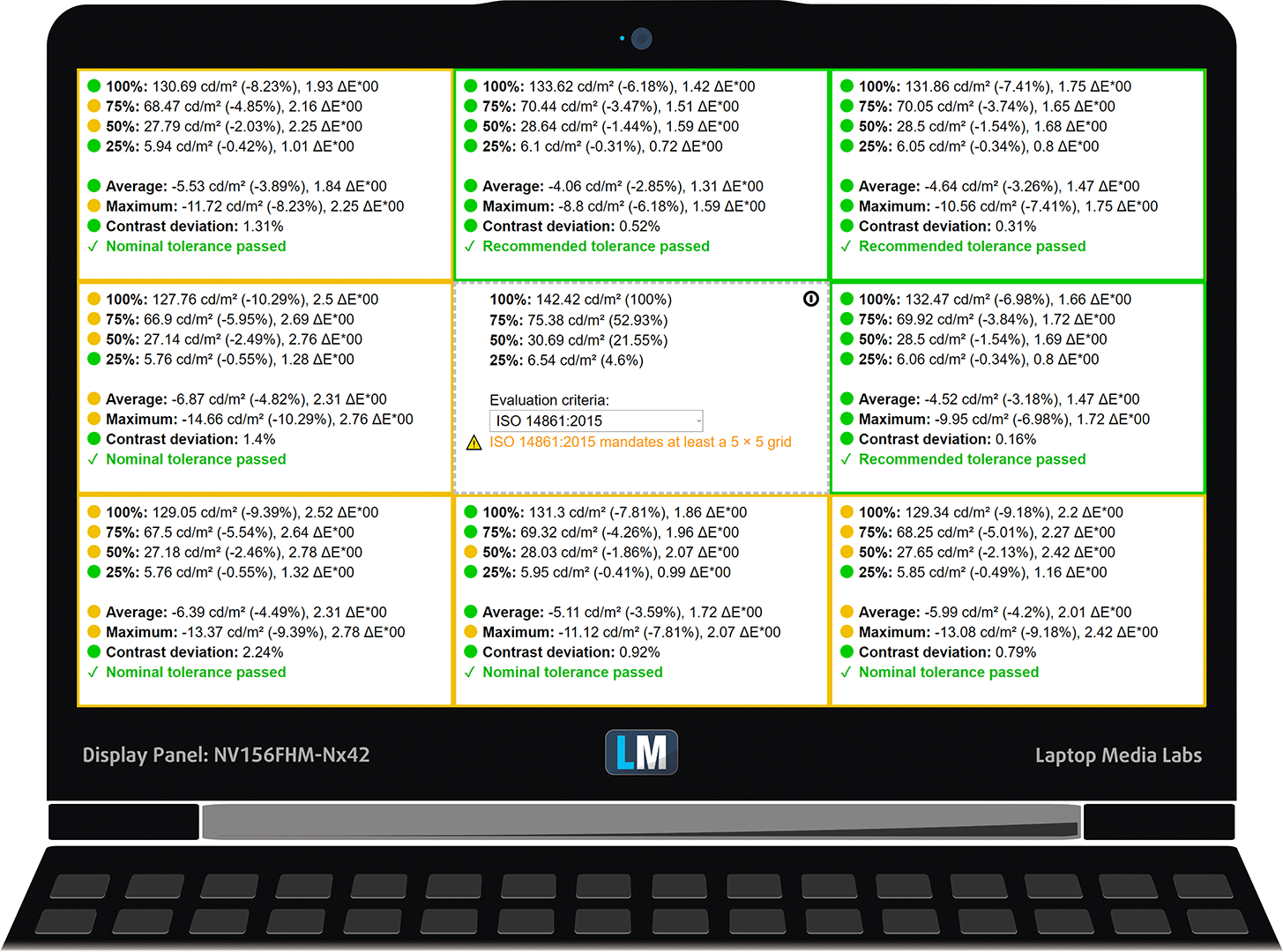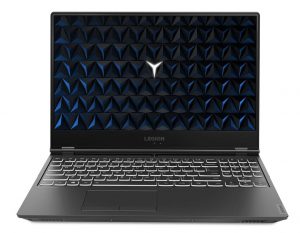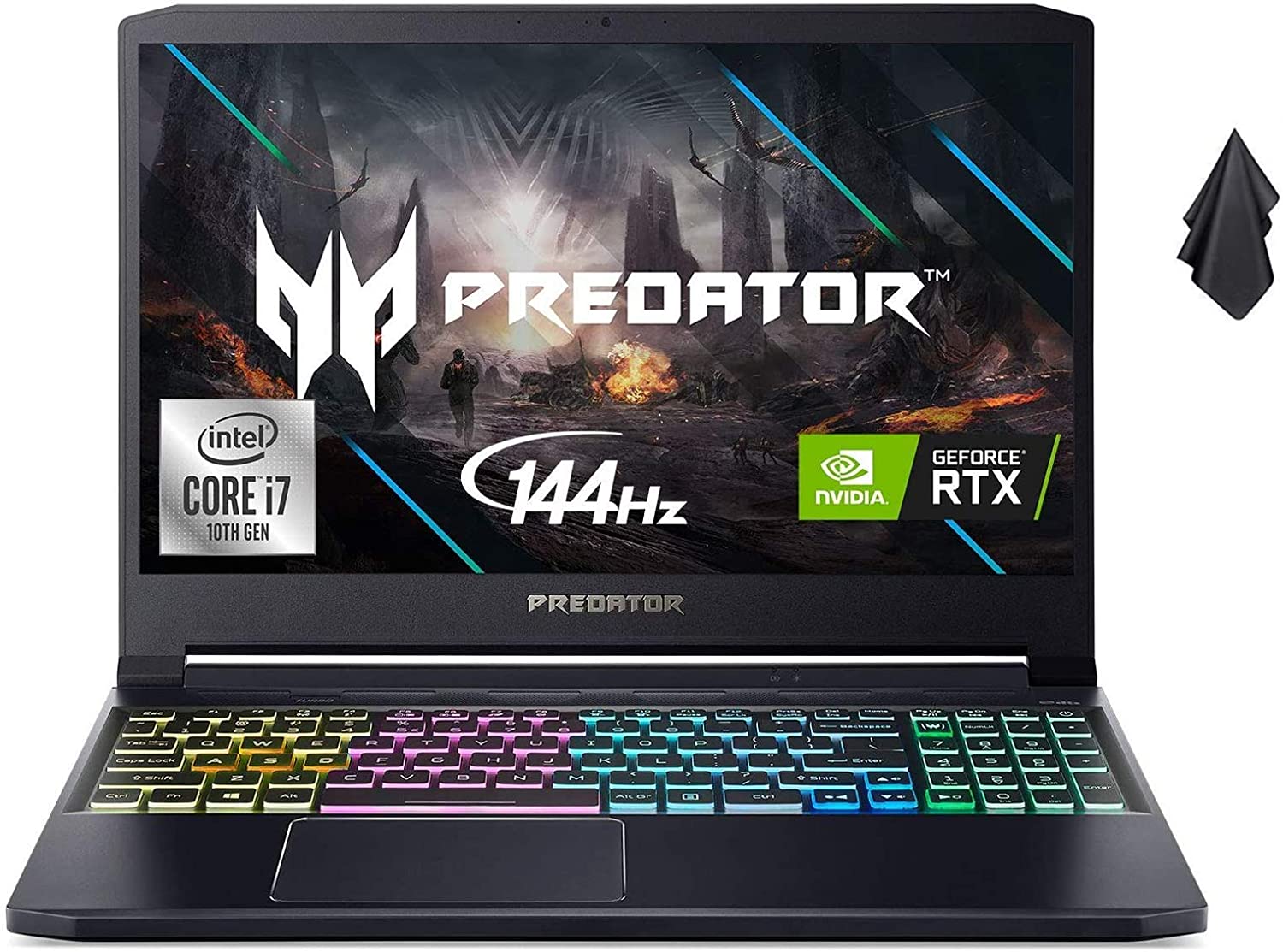Acer Predator Triton 300 (PT315-52) review – stylish design, quick displays, and 10th Gen Intel processors
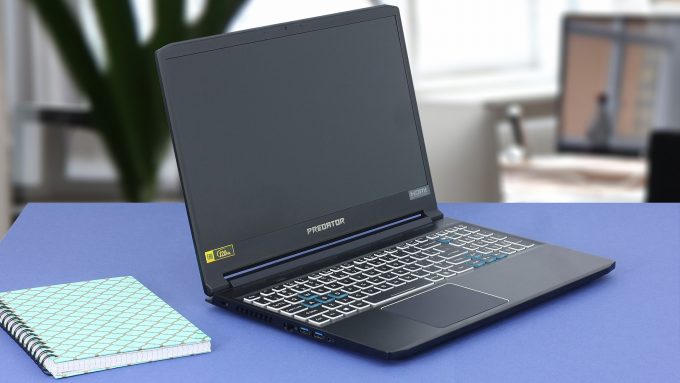 After the Triton 300 (PT315-51) of last year was pretty much a carbon copy of the Helios 300 and the Nitro 5, we were left with something to demand. And now, it seems like Acer has listened. Although the laptop isn’t a dramatic divergence from its predecessor’s design features, there are some fresh little updates all around the device.
After the Triton 300 (PT315-51) of last year was pretty much a carbon copy of the Helios 300 and the Nitro 5, we were left with something to demand. And now, it seems like Acer has listened. Although the laptop isn’t a dramatic divergence from its predecessor’s design features, there are some fresh little updates all around the device.
Let’s start with the hardware. Staying true to Intel, the Predator Triton 300 (PT315-52) is offered with Comet Lake-H processors. More precisely, we are talking about the Core i5-10300H and the Core i7-10750H. Yep, they are merely refreshed versions of their respective predecessors, but they offer higher clock speeds and an improved architecture (yet built on a 14nm node once again). Additionally, the GeForce GTX 1650 Ti makes an appearance here in all its glory.
When it comes to the cooling, we are expecting to see quite lower temps, as this device now has four exhaust grills, compared to only two on the older unit. Additionally, there is a couple of fast refresh rate displays, including a 120Hz and a 144Hz option.
You can check the prices and configurations in our Specs System: https://laptopmedia.com/series/acer-predator-triton-300-pt315-52/
Contents
Specs Sheet
- HDD/SSD
- up to 2000GB SSD
- M.2 Slot
- 3x 2280 M.2 NVMe slot See photo
- RAM
- up to 64GB
- OS
- Windows 10 Home, Linux
- Battery
- 58.7Wh, 4-cell, 58.75Wh
- Body material
- Plastic / Polycarbonate, Aluminum
- Dimensions
- 363.4 x 259.1 x 19.9 mm (14.31" x 10.20" x 0.78")
- Weight
- 2.10 kg (4.6 lbs)
- Ports and connectivity
- 3x USB Type-A
- 3.2 Gen 1 (5 Gbps)
- 1x USB Type-C
- 3.2 Gen 2 (10 Gbps)
- HDMI
- Displayport mini
- Ethernet LAN
- 10, 100, 1000 Mbit/s
- Wi-Fi
- 802.11ax
- Bluetooth
- 5.0
- Audio jack
- 3.5 mm combo
- Features
- Fingerprint reader
- Web camera
- Backlit keyboard
- Microphone
- Speakers
- Stereo Speakers, DTS X:Ultra Audio
- Optical drive
- Security Lock slot
All Acer Predator Triton 300 (PT315-52) configurations
What’s in the box?
Since we got the GeForce GTX 1650 Ti version of the notebook, we received a 135W charger inside the box. Apart from that, there are the mandatory paper manuals, and the Triton 300, itself.
Design and construction
From what we can see, this device retains the aluminum body and lid from last year, which pairs extremely well with the relatively low-budget price tag. Additionally, the laptop is 3mm thinner, down to 19.9mm from the 22.9mm profile of its predecessor. You should also expect a similar weight and a structurally sound chassis. By the way, now the notebook features only the Predator logo, without the signature of the brand, and it glows in blue, as soon as you turn the laptop on.
Thankfully, the lid opens with a single hand, and the bezels are thin on the sides, and quite bulky on the top and bottom. However, on a positive note, there is an HD camera housed in the top bezel. Sadly, though, the lid is all bendy and twisty when you give it more force. It certainly feels cheaper than some of its competitors.
Further down below, there is the great keyboard, coming from the older Triton 300 and the Helios 300. It has a backlight, which can optionally glow in customizable RGB colors. As of the experience, the feedback is clicky, the travel is decent and the keycaps are quite big, which results in comfortable usage when typing and gaming.
As you can see, the WASD and Arrow keys are partially transparent, and more importantly – they are equal in size. Although the larger Arrow keys are going to provide a better experience for some users, we found the proximity to the NumberPad buttons kind of uncomfortable. Additionally, there are two designated keys here – the Predator Sense button, and the Turbo button, which is placed above the keyboard. Of course, the latter could have well been named “the Take off-key”, as it boosts the fans to their maximum potential.
As of the touchpad, it is the same unit we saw last year. It has good gliding properties, big size, and embedded buttons.
Switch the laptop around, and you’ll see slightly larger ventilation grills, compared to last year. Also, now the bottom plate is virtually flat, bearing the features of the more expensive Predator Triton 500. This is also where you’ll find the speaker cutouts, while the hot air escapes from four grills – two on the back and one on each side.
Ports
In contrast to last year, the power plug is moved out of the way and now resides on the back of the machine. Then, on the left side, you’ll see an RJ-45 connector, two USB Type-A 3.1 (Gen. 1) ports and an audio jack. While on the right, you can find a Mini DisplayPort, an HDMI connector, another USB Type-A 3.1 (Gen. 1) port, and a USB Type-A 3.1 (Gen. 2) port.
Disassembly, upgrade options and maintenance
11 Philips-head screws are keeping you away from the internals of the new Predator Triton 300. After you undo them, just pry the bottom panel away with a plastic tool or a guitar pick.
First, let’s take a look at the cooling. It consists of three heat pipes, one of which is common for both the CPU and the GPU. However, despite the low amount of heat pipes, you can see a total of four heat sinks. This, combined with the huge fans and the pretty sizeable metal plates, placed over the VRMs and the video memory, should deliver a more than decent cooling capacity.
In terms of storage, there are three M.2 slots. Not bad for a budget offering. As of the memory, the device supports up to 32GB of DDR4 RAM in dual-channel.
Battery-wise, there is a 58.75Wh unit, which isn’t the largest one out there, but it’s not too small, as well.
Display quality
Acer Predator Triton 300 (PT315-52) in the configuration we tested has a Full HD 120Hz IPS panel with a model number BOE NV156FHM-Nx42 (BOE08F8). Its diagonal is 15.6″ (39.62 cm), and the resolution 1920 х 1080 pixels. The screen ratio is 16:9, and we are looking at a pixel density of – 142 ppi, and a pitch of 0.18 х 0.18 mm. The screen turns into Retina when viewed at distance equal to or greater than 60cm (24″) (from this distance one’s eye stops differentiating the separate pixels, and it is normal for looking at a laptop).
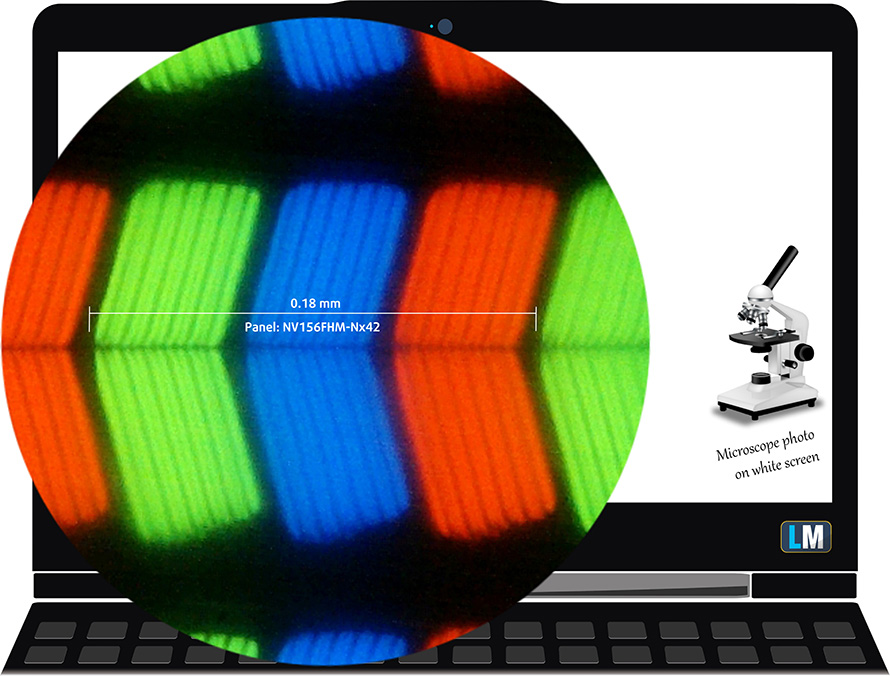
Viewing angles are excellent. We offer images at 45° to evaluate image quality.

We measured a maximum brightness of 285 nits in the middle of the screen and 268 nits as an average for the whole area, with a maximum deviation of 8%. The Correlated Color Temperature on a white screen is 7300K – colder than the optimal for the sRGB standard of 6500K.
In the illustration below you can see how the display performs from a uniformity perspective. In other words, the leakage of light from the light source.
Values of dE2000 over 4.0 should not occur, and this parameter is one of the first you should check if you intend to use the laptop for color-sensitive work. The contrast ratio is not bad – 800:1.
To make sure we are on the same page, we would like to give you a little introduction to the sRGB color gamut and the Adobe RGB. To start, there’s the CIE 1976 Uniform Chromaticity Diagram that represents the visible specter of colors by the human eye, giving you a better perception of the color gamut coverage and the color accuracy.
Inside the black triangle, you will see the standard color gamut (sRGB) that is being used by millions of people in HDTV and on the web. As for the Adobe RGB, this is used in professional cameras, monitors, etc for printing. Basically, colors inside the black triangle are used by everyone and this is the essential part of the color quality and color accuracy of a mainstream notebook.
Still, we’ve included other color spaces like the famous DCI-P3 standard used by movie studios, as well as the digital UHD Rec.2020 standard. Rec.2020, however, is still a thing of the future and it’s difficult for today’s displays to cover that well. We’ve also included the so-called Michael Pointer gamut, or Pointer’s gamut, which represents the colors that naturally occur around us every day.
The yellow dotted line shows Acer Predator Triton 300 (PT315-52)’s color gamut coverage.
Its display covers only 50% of the sRGB/ITU-R BT.709 (web/HDTV standard) in CIE1976.
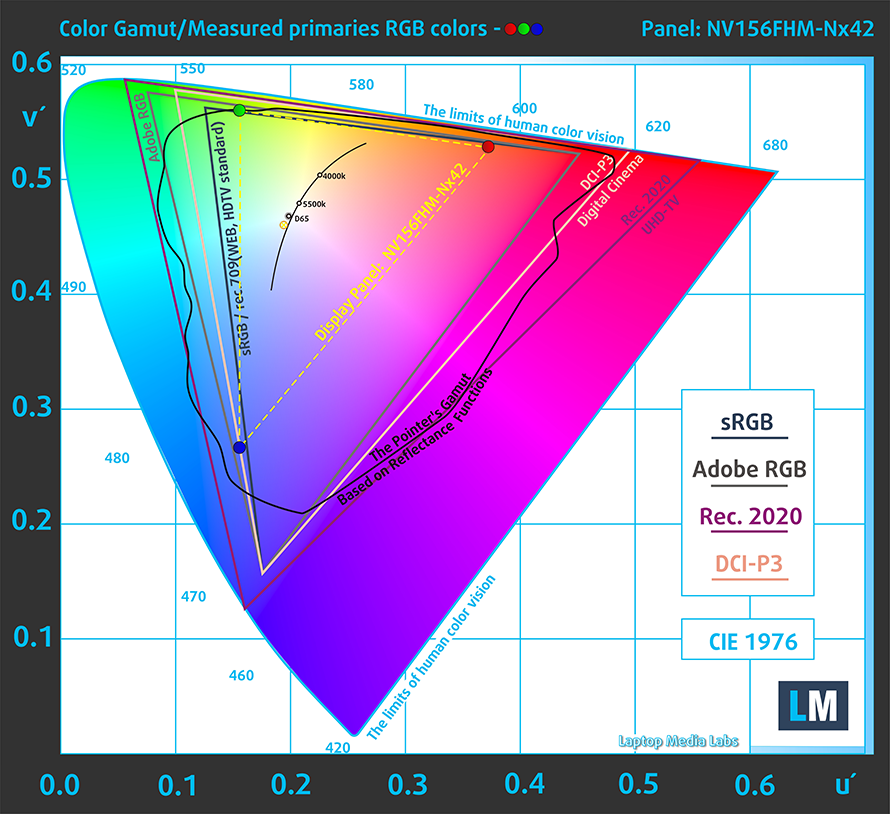
Our “Design and Gaming” profile delivers optimal color temperature (6500K) at 140 cd/m2 luminance and sRGB gamma mode.
We tested the accuracy of the display with 24 commonly used colors like light and dark human skin, blue sky, green grass, orange, etc. You can check out the results at factory condition and also, with the “Design and Gaming” profile.
Below you can compare the scores of Acer Predator Triton 300 (PT315-52) with the default settings (left), and with the “Gaming and Web design” profile (right).
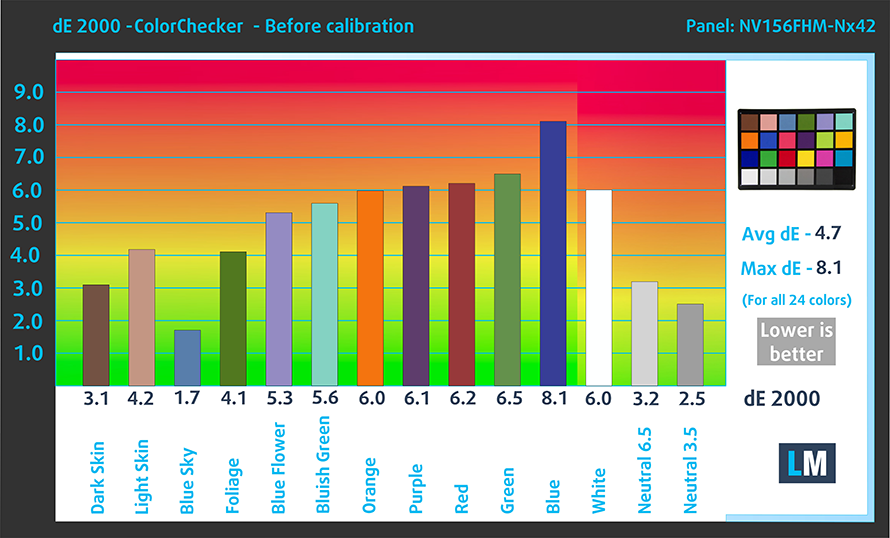
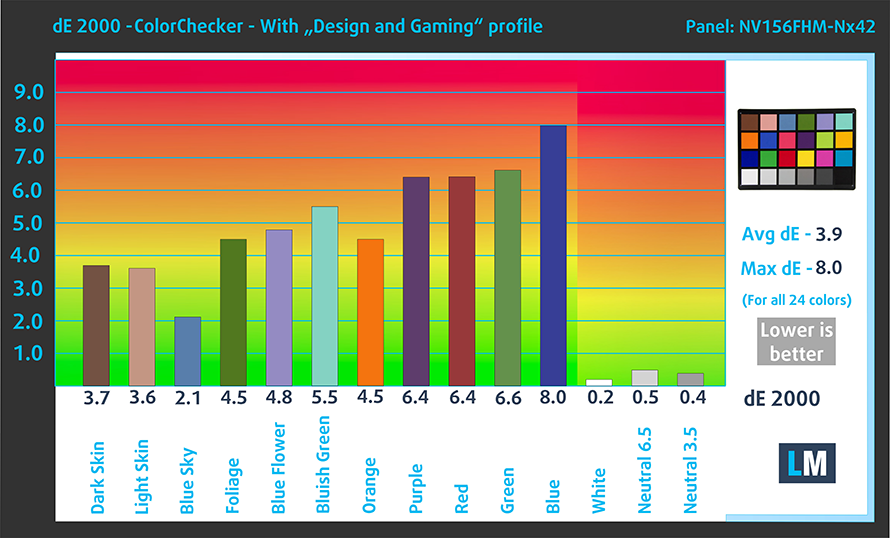
The next figure shows how well the display is able to reproduce really dark parts of an image, which is essential when watching movies or playing games in low ambient light.
The left side of the image represents the display with stock settings, while the right one is with the “Gaming and Web Design” profile activated. On the horizontal axis, you will find the grayscale and on the vertical axis – the luminance of the display. On the two graphs below you can easily check for yourself how your display handles the darkest nuances but keep in mind that this also depends on the settings of your current display, the calibration, the viewing angle, and the surrounding light conditions.
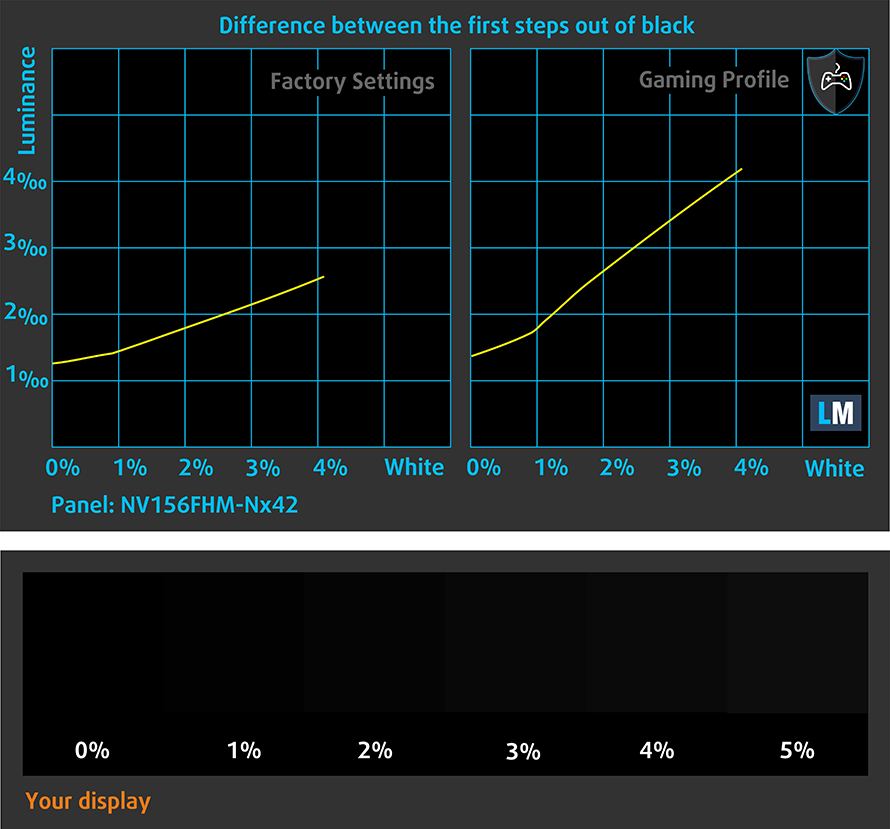
Response time (Gaming capabilities)
We test the reaction time of the pixels with the usual “black-to-white” and “white-to-black” method from 10% to 90% and vice versa.
We recorded Fall Time + Rise Time = 16 ms.

We also tested the response times GtG (Gray to Gray) from 50% White to 80% White and vice versa between the 10% and 90% of amplitudes.
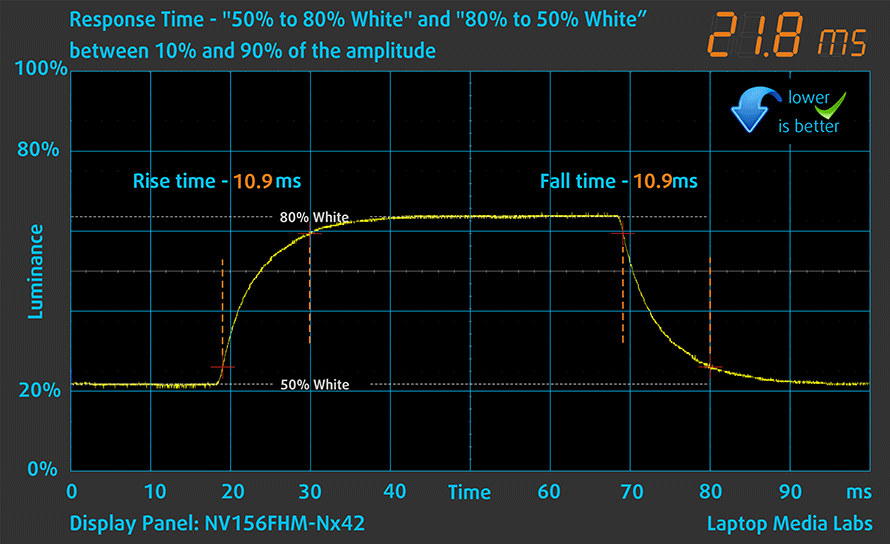
PWM (Screen flickering)
Pulse-width modulation (PWM) is an easy way to control monitor brightness. When you lower the brightness, the light intensity of the backlight is not lowered, but instead turned off and on by the electronics with a frequency indistinguishable to the human eye. In these light impulses, the light/no-light time ratio varies, while brightness remains unchanged, which is harmful to your eyes. You can read more about that in our dedicated article on PWM.
Acer Predator Triton 300 (PT315-52)’s display doesn’t flicker at any brightness level. This provides comfort in extended periods of use.

Blue light emissions
Installing our Health-Guard profile not only eliminates PWM but also reduces the harmful Blue Light emissions while keeping the colors of the screen perceptually accurate. If you’re not familiar with the Blue light, the TL;DR version is – emissions that negatively affect your eyes, skin, and your whole body. You can find more information about that in our dedicated article on Blue Light.
Conclusion
Acer Predator Triton 300 (PT315-52)’s display has an IPS panel with a Full HD resolution, comfortable viewing angles, decent contrast ratio, and non-flickering backlight. Additionally, the 120Hz refresh rate and rather quick response times would be enjoyed by gamers. However, the color accuracy and the color coverage are both quite limited, making it inappropriate for any design work, whatsoever.
Buy our profiles
Since our profiles are tailored for each individual display model, this article and its respective profile package are meant for Acer Predator Triton 300 (PT315-52) configurations with 15.6″ FHD IPS BOE NV156FHM-Nx42 (BOE08F8).
*Should you have problems with downloading the purchased file, try using a different browser to open the link you’ll receive via e-mail. If the download target is a .php file instead of an archive, change the file extension to .zip or contact us at [email protected].
Read more about the profiles HERE.
In addition to receiving efficient and health-friendly profiles, by buying LaptopMedia's products you also support the development of our labs, where we test devices in order to produce the most objective reviews possible.

Office Work
Office Work should be used mostly by users who spend most of the time looking at pieces of text, tables or just surfing. This profile aims to deliver better distinctness and clarity by keeping a flat gamma curve (2.20), native color temperature and perceptually accurate colors.

Design and Gaming
This profile is aimed at designers who work with colors professionally, and for games and movies as well. Design and Gaming takes display panels to their limits, making them as accurate as possible in the sRGB IEC61966-2-1 standard for Web and HDTV, at white point D65.

Health-Guard
Health-Guard eliminates the harmful Pulse-Width Modulation (PWM) and reduces the negative Blue Light which affects our eyes and body. Since it’s custom tailored for every panel, it manages to keep the colors perceptually accurate. Health-Guard simulates paper so the pressure on the eyes is greatly reduced.
Get all 3 profiles with 33% discount
Sound
Acer Predator Triton 300 (PT315-52)’s speakers produce a rather quiet sound with decent quality. However, there are some deviations throughout the entire frequency range.
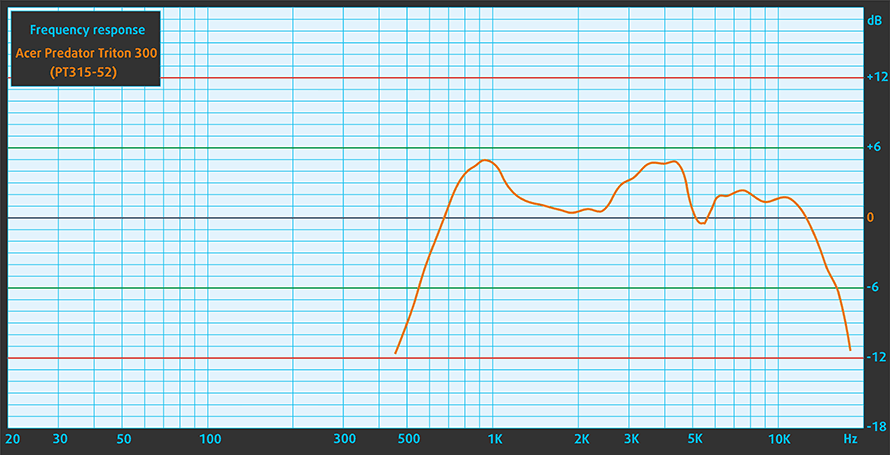
Drivers
All of the drivers and utilities for this notebook can be found here: https://www.acer.com/ac/en/US/content/drivers
Battery
Now, we conduct the battery tests with Windows Better performance setting turned on, screen brightness adjusted to 120 nits, and all other programs turned off except for the one we are testing the notebook with. We got around 8 hours of Web browsing and video playback from the 58.75Wh package.
In order to simulate real-life conditions, we used our own script for automatic web browsing through over 70 websites.

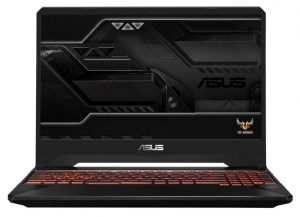
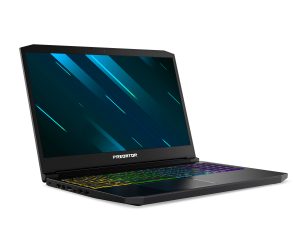

For every test like this, we use the same video in HD.




CPU options
As we mentioned, the two CPU options here are the Core i5-10300H (4c/8t), and the Core i7-10750H (6c/12t). Both of them are built on the 14nm architecture and have a TDP of 45W.
Results are from the Cinebench 20 CPU test (the higher the score, the better)
Results are from our Photoshop benchmark test (the lower the score, the better)
GPU options
Our unit comes with the NVIDIA GeForce GTX 1650 Ti. It has 4GB of GDDR6 memory, a maximum TGP of 50W, and base – boost frequencies of 1350-1485 MHz.
Results are from the 3DMark: Time Spy (Graphics) benchmark (higher the score, the better)
Results are from the 3DMark: Fire Strike (Graphics) benchmark (higher the score, the better)
Results are from the Unigine Superposition benchmark (higher the score, the better)
Acer Predator Triton 300 (PT315-52) GPU variants
Here you can see an approximate comparison between the GPUs that can be found in the Acer Predator Triton 300 (PT315-52) models on the market. This way you can decide for yourself which Acer Predator Triton 300 (PT315-52) model is the best bang for your buck.
Note: The chart shows the cheapest different GPU configurations so you should check what the other specifications of these laptops are by clicking on the laptop’s name / GPU.
Results are from the 3DMark: Time Spy (Graphics) benchmark (higher the score, the better)
Results are from the 3DMark: Fire Strike (Graphics) benchmark (higher the score, the better)
Results are from the Unigine Superposition benchmark (higher the score, the better)
Gaming tests


| Far Cry 5 | Full HD, Normal (Check settings) | Full HD, High (Check settings) | Full HD, Ultra (Check settings) |
|---|---|---|---|
| NVIDIA GeForce GTX 1650 Ti | 70 fps | 65 fps | 60 fps |

| Rise of the Tomb Raider (2016) | Full HD, Lowest (Check settings) | Full HD, Medium (Check settings) | Full HD, Very High (Check settings) |
|---|---|---|---|
| NVIDIA GeForce GTX 1650 Ti | 126 fps | 86 fps | 43 fps |

| Shadow of the Tomb Raider (2018) | Full HD, Lowest (Check settings) | Full HD, Medium (Check settings) | Full HD, High (Check settings) |
|---|---|---|---|
| NVIDIA GeForce GTX 1650 Ti | 100 fps | 59 fps | 54 fps |

| Tom Clancy’s Ghost Recon Wildlands | Full HD, Medium (Check settings) | Full HD, High (Check settings) | Full HD, Very High (Check settings) |
|---|---|---|---|
| NVIDIA GeForce GTX 1650 Ti | 66 fps | 60 fps | 53 fps |
Temperatures and comfort
Max CPU load
In this test we use 100% on the CPU cores, monitoring their frequencies and chip temperature. The first column shows a computer’s reaction to a short load (2-10 seconds), the second column simulates a serious task (between 15 and 30 seconds), and the third column is a good indicator of how good the laptop is for long loads such as video rendering.
Average core frequency (base frequency + X); CPU temp.
| Intel Core i5-10300H (45W TDP) | 0:02 – 0:10 sec | 0:15 – 0:30 sec | 10:00 – 15:00 min |
|---|---|---|---|
| Acer Predator Triton 300 (PT315-52) | 3.35 GHz (B+34%) @ 72°C | 3.33 GHz (B+33%) @ 79°C | 3.31 GHz (B+32%) @ 84°C |
Even though the Core i5-10300H is “just” a quad-core CPU, it can still be a pretty big of a burden to the cooling with its 45W TDP. However, the Predator Triton 300 (PT315-52) managed to handle it without breaking a sweat.
Real-life gaming
| NVIDIA GeForce GTX 1650 Ti | GPU frequency/ Core temp (after 2 min) | GPU frequency/ Core temp (after 30 min) | GPU frequency/ Core temp (Turbo mode) |
|---|---|---|---|
| Acer Predator Triton 300 (PT315-52) | 1581 MHz @ 70°C | 1551 MHz @ 78°C | 1673 MHz @ 66°C |
| ASUS TUF A15 (F506) | 1566 MHz @ 68°C | 1549 MHz @ 69°C | – |
Well, this certainly can’t be said about the graphics department, though. After 30 minutes of gameplay, we got 78C on that GeForce GTX 1650 Ti. Comparing it to the ASUS TUF A15, we see a 9C difference. On the bright side, you have the Turbo mode at your disposal. As it spreads its wings and flies away, it is able to decrease the temperature by 12C and increase the frequency of the core with 120 MHz. Not bad.
Gaming comfort
Ultimately, the laptop is not amongst the loudest out there. And although it reaches the quite warm 48C, it is not too hot for your fingers. However, the Turbo mode is horrendous. You certainly need headphones with something in the ballpark of Iron Maiden.


Verdict
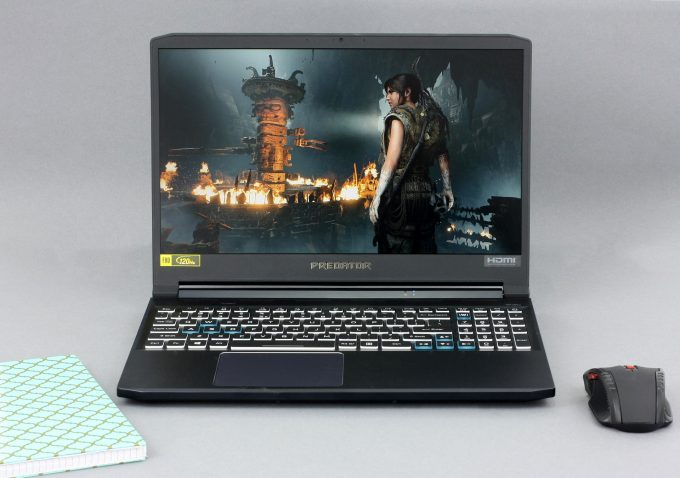 Well, the Triton 300 (PT315-52) is a decent gaming machine. Provided that its price tag is kept relatively low, it has the potential to be both your go-to gaming machine and even your daily driver. How come? Well, we were able to get around 8 hours of Web browsing and video playback from the battery, which is exceptional for a gaming notebook. Especially, given the 58.75Wh battery, which is nowhere near what some manufacturers offer.
Well, the Triton 300 (PT315-52) is a decent gaming machine. Provided that its price tag is kept relatively low, it has the potential to be both your go-to gaming machine and even your daily driver. How come? Well, we were able to get around 8 hours of Web browsing and video playback from the battery, which is exceptional for a gaming notebook. Especially, given the 58.75Wh battery, which is nowhere near what some manufacturers offer.
Additionally, the performance of the thing was great. You can enjoy pretty much every AAA title at reasonable settings but with one caveat – at 1080p. So, if you own a monitor with a higher resolution, and plan to game on it, you have to keep that in mind. On the other side, the cooling solution of this notebook happens to have some difficulties with the GTX 1650 Ti. Sure, there is the Turbo button, which makes it omnipotent, but it is very uncomfortable due to the high noise output. So, comparing this notebook to the ASUS TUF A15, it is actually worse for gaming. Not to mention the superiority of the AMD processors inside of the latter.
By the way, one of the biggest selling points of this device is the storage options. There are not two, but three M.2 slots at your disposal. What are you going to do with all of them? Additionally, you get two RAM SODIMM slots, which work in dual-channel and support up to 32GB of DDR4 memory.
On the downside, there is no SD card reader on board, so you might want to get a dongle if you are a photographer, or you happen to upload files from an SD card. Additionally, you won’t be getting any Thunderbolt certification. However, the sad truth about that, is that this certification is quite expensive for some manufacturers, pretty much making it impossible to see in a budget gaming machine.
Acer Predator Triton 300 (PT315-52)’s display has an IPS panel with a Full HD resolution, comfortable viewing angles, decent contrast ratio, and non-flickering backlight. Additionally, the 120Hz refresh rate and rather quick response times would be enjoyed by gamers. However, the color accuracy and the color coverage are both quite limited, making it inappropriate for any design work, whatsoever.
Thankfully, though, the build quality is good, the machine looks sleeker than ever before, and it offers comfortable input devices.
So, at the end of the day, you have a lot of options in this segment. Should you go for this bad boy, or bet your money on the AMD-equipped ASUS TUF A15, it is totally up to you. What we know for sure, though, is that a lot of exciting gaming laptops are coming to the market, and you should certainly check them out, before you make your final decision.
Pros
- Great price/performance ratio
- Good keyboard with decent travel, clicky feedback, and an optional RGB backlight
- Three M.2 slots
- The display doesn’t flicker at any brightness level (LM156LF-2F01)
- Has a good contrast ratio and comfortable viewing angles (LM156LF-2F01)
- 120Hz and 144Hz fast display options
Cons
- Lacks an SD card reader and Thunderbolt support
- Either you get warm internals or fans that will blow your ears off
- Covers only 50% of sRGB and has slow response times (despite the fast refresh rate) (LM156LF-2F01)
You can check the prices and configurations in our Specs System: https://laptopmedia.com/series/acer-predator-triton-300-pt315-52/

